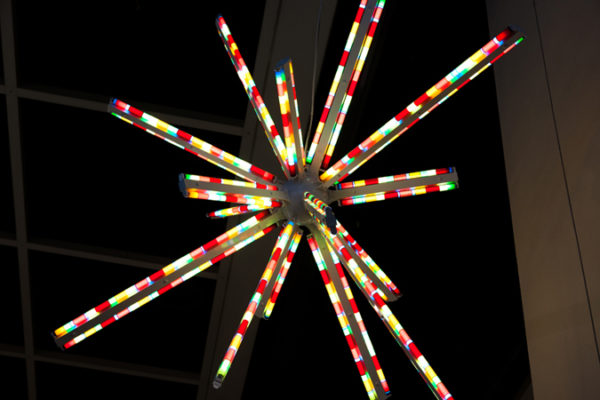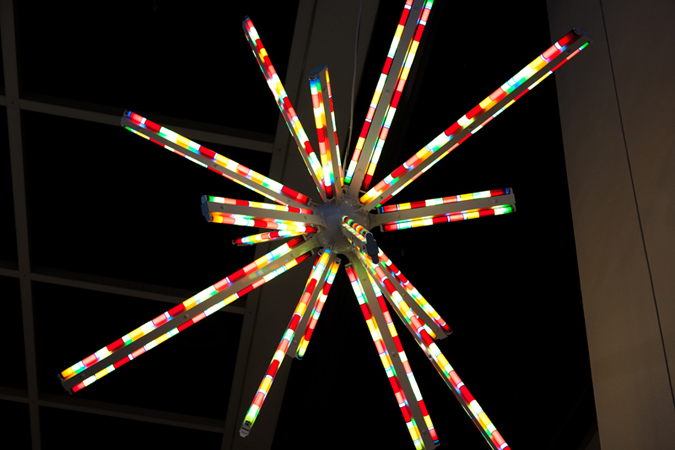
I sat for a long time, chin rested on fist, staring at artist Spencer Finch’s neon sculpture, “Betelgeuse.” I remained waiting for the celestial light bulb of inspiration to glow over my head like it does for “The Thinker,” a statue by Rodin renowned for its eternal pensive state that sits beneath Finch’s. Failing, I sought out some expert advice. Two young girls of about nine or ten sat a few meters away from me on the upper balcony also looking at this sculpture hanging from the domed ceiling, drawing it. I find that oftentimes children are much more honest than adults, so I wandered over to them and asked their opinions. The more confident of the two responded “I like it!” I asked her why and she hesitated for a moment before answering: “ I guess you could say it’s really colorful!” She wasn’t wrong. This neon glows with a pulsing halo of rainbow hues from an orb-like center that draws in all eyes, old and young.
Childishness is an interesting quality in art, and at first glance that is exactly what I would call “Betelgeuse”: an easy piece of eye candy. However, Finch creates much more than that simple description. This piece, in particular, is named after “Betelgeuse,” the ninth-brightest star in the night sky and the second brightest star in the Orion constellation. In order to create works like “Betelgeuse,” Finch uses a colorimeter — a device for measuring the wavelengths of light — to record the paints that color the natural world. Finch concentrates the hues and reduces a mere slice of life into one perennial object, be it a sculpture, a painting or a stained glass window.
His methods are precise and scientific — Finch has distilled the process of art-making into a chemistry. The placement of this work above the colossal Rodin sculpture that emanates the power of knowledge is not an accident. Cantor Arts Center is passionately trying to draw the campus’ tech community into the art world, as the two disciplines often lie separate. What better way to do that than by combining science with art and placing “Betelgeuse” above the infamous figure that represents the humanities? “Betelgeuse” represents a symbol of science, an emblem of modernity. In spite of this cynical innuendo, I do not believe this sculpture exists to serve such a simple purpose. Finch previously created a memorial work commissioned by the National September 11 Memorial & Museum. For this piece, Finch drained the myriad of blues in the sky on 9/11 to hand-paint a different blue shade on 2,983 individual squares of Fabriano Italian paper. Each square represents one person killed in the Sept. 11 attacks and in the 1993 bombing of the World Trade Center. Although “Betelgeuse” does not memorialize or commemorate, it instead celebrates the simplicity of both knowledge and beauty within its extending arms of powder-coated steel, fluorescent light and colored filters.
Finch’s approach to his work involves an innate sensibility to examine how we see the world as he forces us to look at it differently and question our own sense of time, memory and perception. Light and color are his primary tools, by which he binds the outside world with a poeticism of inner thought. My own inner thoughts on the sculpture, however, remain tidal. Nevertheless, that is what I think good art does — it divides us and leaves enough room for ambiguity. So I remain in my state of childlike awe, as this is the closest I will ever be to the star.
“New to the Cantor: Spencer Finch” is ongoing every day at the Cantor Arts Center until Dec. 31.
Contact Angelica Jopling at ajopling ‘at’ stanford.edu.
